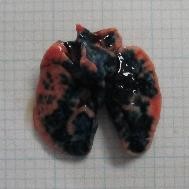MODEL LINEUP
Bleomycin-induced pulmonary fibrosis model
IPF Model
The Bleomycin (BLM) induced pulmonary fibrosis model is our standard IPF model, widely used in pharmacology and fundamental research. For the BLM model there are four types of administration route: subcutaneous, intraperitoneal, tail intravenous and intratracheal, each route with their own pathological features and imaging. The disease IPF is defined as injury confined to the lungs. Since subcutaneous, intraperitoneal and tail vein routes of administration cause systemic injury and deviate from the clinical definition of IPF, SMC utilizes the Microsprayer to perform intratracheal administration of bleomycin (Figure 1). By administering bleomycin via Microsprayer, it can be evenly exposed to the lungs and thus, develops a reproducible and uniform pathology. In prevention studies we often recommend dexamethasone as a positive control. However, for therapeutic targeting studies we recommend using a positive control such as Nintedanib. To date, we have extensive experience in evaluating various categories of test substances such as small molecules, nucleic acids and antibodies.

Figure 1. A Microsprayer can evenly expose lungs to the drugs.
The picture shows the distribution of pigment Evans Blue.
